Subway Stations
Subway stations in Japan look much like stations elsewhere in the world: harsh fluorescent lighting, light-colored tile floors and walls, high-visibility yellow safety lines, and fairly dirty track. Not to mention all the advertising. However, Japanese subway stations lack the general grime found in such stations in many other parts of the world.
That’s not true of all of them, of course. Some older stations retain brickwork, or at least brick-pattern tile, floors or walls, and not all are brightly lit or spotlessly clean.
Unfortunately most of the photographers of the images below neglected to note just which stations, or even lines, were being photographed. If fact, some stations described as “subway” by their photographer were clearly commuter-line stations (which use heavier, longer, and wider cars), even some above ground. I avoided the obvious errors, and identified lines and stations where I could, but given the lack of info not all of these may strictly be “subway” stations. But then, the line between subway and railway is a bit vague in Japan anyway. Regardless, all of these images represent underground stations in the Tōkyō region (including adjacent cities outside the 23 wards).
Bill on the JNS Forum pointed me at a collection of photos of Tōkyō train stations hosted by nycsubway.org, well worth looking through.
Platforms
Station platforms may be light or dark, wide or narrow, and arranged between the tracks or on the outside. Construction may be very modern, or older concrete or even riveted steel beams in the oldest stations.
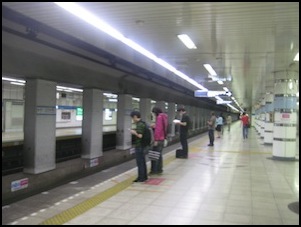
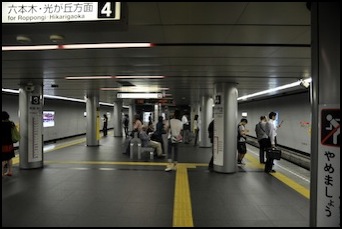
L: Typical side-platform subway station (Asakusa, Tōkyō), R: Typical central-island platform subway station (Tōkyō)
Photographers: woofiegrrl, caribb
Although the track in the subway is much dirtier than the platforms, it lacks the buildup of loose paper and other trash often observed in other parts of the world. Also, the platforms aren’t universally spic-n-span; there is some buildup of dirt, particularly where people have been standing, as can be seen in the right photo below.
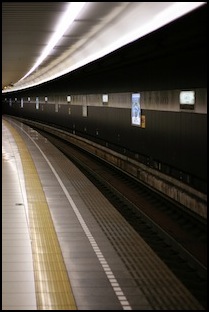
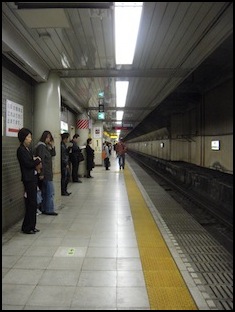
L: Subway Tracks by Platform (Tōkyō), R: A more grimy platform (Tōkyō)
Photographers: HokutoSuisse, oblivionz
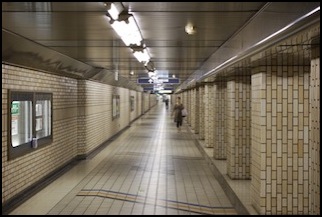
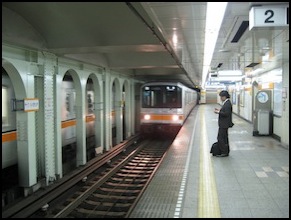
L: Ginza subway station (Ginza, Tōkyō), R: Ginza Line station, possibly Asakusa, note third rail (Tōkyō)
Photographers: sortulv, Slick Vic
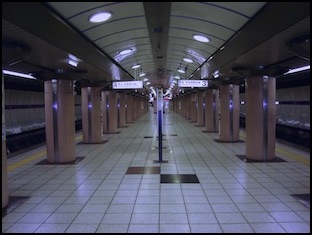
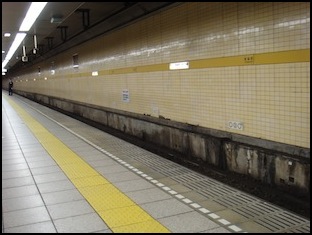
L: Empty station at 5 AM (Nagatacho Station, Hanzomon Line, Tōkyō), R: Possibly Iidabashi station (Tokyo Metro Yūrakuchō line, Tōkyō)
Photographers: Joe Jones, HAMACHI!
Advertising
Although ads are everywhere in Japan, and particularly in Tōkyō, the advertising in the subway stations seems to be relatively low-key for the most part. Note how little appears in the photos above. However, stations are not without platform advertising banners, both large and small, as seen below.
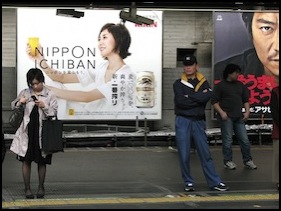
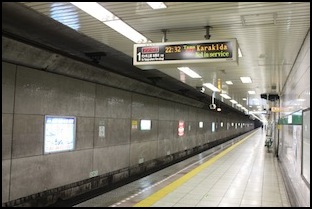
L: Large banner advertisements (Tōkyō), R: Tōkyō Metro Chiyoda line: Small ads, widely spaced (Sendagi Station, Bunkyō, Tōkyō)
Photographers: Todd Mecklem, torisan3500

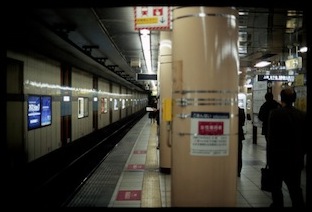
L: Large banner ad (in a set with others from Tōkyō), R: Paired smaller ads (unknown)
Photographers: dianaschnuth, gullevek


L: Terminator wall ad (Tōkyō), R: Transformers ad between tracks (Tōkyō)
Photographer (both): schnuth
Platform Gates
Most subway platforms do not have any separation of passengers from the trains, although that is slowly changing, with gated barriers being added to keep passengers from falling on the tracks. Although there is a problem with people choosing trains as a method of suicide, accidents are more common, and many of the gates being introduced are half-height, sufficient to prevent crowding from forcing someone over the edge, but not intended to deter a would-be suicide.
The typical name for these in Japanese is “ホームドア” (Home Door), typically translated to English as Platform Screen Doors, or Automatic Platform Gates. The common half-height form is known as a “可動式ホーム柵” (Movable Fence Home).
Although gates are being added to other lines (including the above-ground Yamanote line), many lines do not have them, and lines that do have them, do not necessarily have them at all stations. Tōkyō subway lines I know to have gates today or be planning them are the Tokyo Metro’s Chiyoda, Fukutoshin, Ginza, Marunouchi, Namboku (full height) and Yurakucho lines, and the Toei Mita and Oedo (planned 2013) lines. Additionally the Tōkyū Meguro, Oimachi (planned 2011) and Toyoko lines and JR East’s Yamanote line also have gates. Note: the Namboku and Mita lines interconnect with the Tōkyū Meguro railway (which also has gates), so all three have to have the same door spacing. For more on this, see the Japanese wikipedia page on Home Doors.
The first photo on the left shows a full-height gate on the Toei subway (unclear which line, but likely the Mita line), which added these when they removed conductors from the trains (there is still a “motorman” driving the train, who is also responsible for remotely opening/closing and checking doors). The other photos show the more common half-height gates.
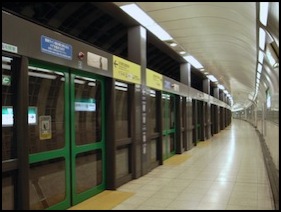
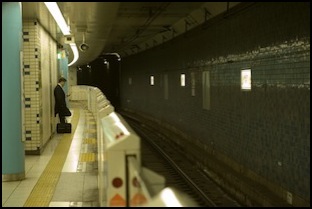
L: Platform gates, full height - likely Toei Mita line (Tōkyō), R: Platform gates, half-height (Tōkyō)
Photographer (both): dianaschnuth
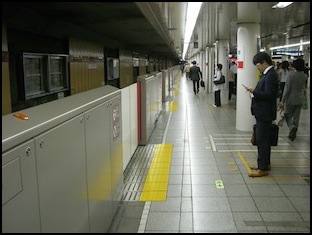
Platform gates, half-height, gray (Tōkyō - likely Tokyo Metro Marunouchi line)
Photographer: achimh




